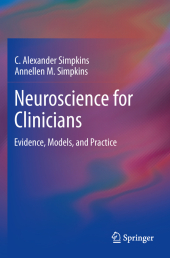 Neuerscheinungen 2012Stand: 2020-01-07 |
Schnellsuche
ISBN/Stichwort/Autor
|
Herderstraße 10
10625 Berlin
Tel.: 030 315 714 16
Fax 030 315 714 14
info@buchspektrum.de |

Annellen M. Simpkins, C. Alexander Simpkins
(Beteiligte)
Neuroscience for Clinicians
Evidence, Models, and Practice
2012. xix, 345 S. 98 SW-Abb. 235 mm
Verlag/Jahr: SPRINGER, BERLIN 2012
ISBN: 1-461-44841-7 (1461448417)
Neue ISBN: 978-1-461-44841-9 (9781461448419)
Preis und Lieferzeit: Bitte klicken
This is an introductory text that opens the field of neuroscience up to the beginner and takes them to higher-level thinking about neuroscience. The book helps readers navigate the conventions used to describe the brain that developed through the years.
Neuroscience for Clinicians: Evidence, Models, and Practice
C. Alexander Simpkins and Annellen M. Simpkins
Psychology began as the study of thoughts, moods, and emotions the realm of the mind gradually adding findings from neuroscience about the workings of the brain. Current interest in mind-body health and in the biological underpinnings of mental illness is creating new opportunities for therapists to bring brain and mind together in the treatment room.
Neuroscience for Clinicians introduces an elegant new lens not only for understanding the role of the brain in pathology, but also for using this knowledge in therapy, to help the mind by treating the brain. Offering conceptual models and empirical data as well as hands-on techniques and practical guidelines, it describes methods versatile enough to be used by therapists across theoretical orientations. Detailed discussion of neuroplasticity explores the brain s capacity for change and in-depth case studies of anxiety, substance abuse, cognitive problems, and mood disorders demonstrate the mind s ability to alter brain structures during the course of therapy. And the book is written at a comfort level that requires no previous neuroscience background. Featured in the coverage:
Learning from brain-damaged individuals.How neurons think and learn.Neuroplasticity and neurogenesis: moment-by-moment change.Incorporating the brain into treatment.Maximizing the social brain.Shifting the nervous system in common disorders.Clinicians interested in understanding the brain s interactions with the mind and its role in psychological problems will find Neuroscience for Clinicians stimulating and adaptable to their own approaches to therapy. The book can also enhance neuroscience and biological psychology classes in cognitive science, medical, and psychology departments.
The birth of a new science.-Unlocking the key to neuroscience terminology.- What is the Mind and Brain?.- Learning from brain damaged individuals.- Neuroimaging technologies.- Modeling the Brain.- Neurons and Neurotransmitters.- Brain structures.- Brain Pathways.- Neural Networks: How Neurons Think and Learn.- Evolution of the Brain over Ions of Time.- Brain Development through the Life Span.- Neuroplasticity and Neurogenesis: Changing Moment-by-Moment.- Principles for incorporating the Brain into Treatment.- Working with Attention.- Regulating Emotions.- Reconsolidating Memory.- Maximizing the Social Brain.- How Psychotherapy Changes the Brain.- Relieving Anxiety.- Finding a Better Balance for Depression and Bipolar Disorder.- Recovering from Addiction.


